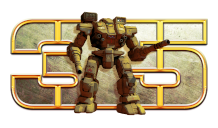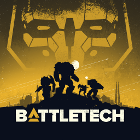- Home
- New To BattleTech?
- MUL
- Forums
- News
- Books
- Shrapnel
- Universe
- Downloads
- Characters
- Community
- Errata
- Links
- Gallery
WHAT IS THE BATTLEMECH MANUAL?
On January 27, 2017
When Total Warfare (TW) came out in 2006, it was the fifth major BattleTech rules compendium. Coming eight years after the BattleTech Master Rules, it drew on over twenty years of gameplay experience in an attempt to make the best collection of the BattleTech rules possible.
While Total Warfare was by far the most thorough BattleTech rulebook ever released, its very thoroughness frustrates some. The fact that it has fiction designed to help immerse you in the universe, advice on painting and modelling, and rules for almost every unit type in the game (including rules for how all those rules interact with each other) means that the heart of the game, the BattleMech, can get lost in its 312 pages. For some people, all this other material just gets in the way of getting right into stompy robot action.
At the same time, just as the lessons of previous rulebooks informed Total Warfare, we’ve learned a lot about how to make books in the ten-plus years since it was released. Ten years of release means ten years of use at the tabletop and ten years of feedback on its layout, its wording, and other aspects.
As such, it was decided that the time had come to put together a new rulebook. Not a new edition, but a book that took all that play experience and feedback and channelled it into a new, ’Mech-only tome, designed from the ground up for clarity, ease of use, and play at the tabletop, intended both for beginners and vets. That’s the new BattleMech Manual.
The Process
We started by taking the text of the most recent printing of Total Warfare, which ensured we had all errata to date in our base text. At the same time, there was an additional three years of errata not yet collected in any printing that we added in.
Next we cut all the non-’Mech information. All the fiction, all the modelling advice, all the construction rules, all the rules not related to ’Mech gameplay: all gone. This was a huge savings in text right there, but we kept cutting. We went out of our way to trim text whenever possible, to make sentences tighter: every word trimmed is one bit faster that someone can read a rule in the middle of a game. Overall, even after removing the non-’Mech rules, the text is about 15% shorter than in TW.
That having been said, improved clarity was a major goal of this project, and so nothing was cut if it came at the expense of understanding. Some sections were even expanded if player feedback indicated that they were confusing. I read through ten years of Total Warfare rules forums posts to see what tended to trip people up, and issues such as TAG, ammo usage, and critical hit transferral were all given a more thorough treatment.
All this left us with a pile of well-edited text. But we wanted to take it a bit further, so we re-examined the layout of Total Warfare itself, to see if we could make the rules flow better. For example, in TW the Movement chapter starts with a discussion on water, difficult terrain, and level changes. However, if you don’t even know how to get and spend MP or change your facing yet, then this information might just be confusing.
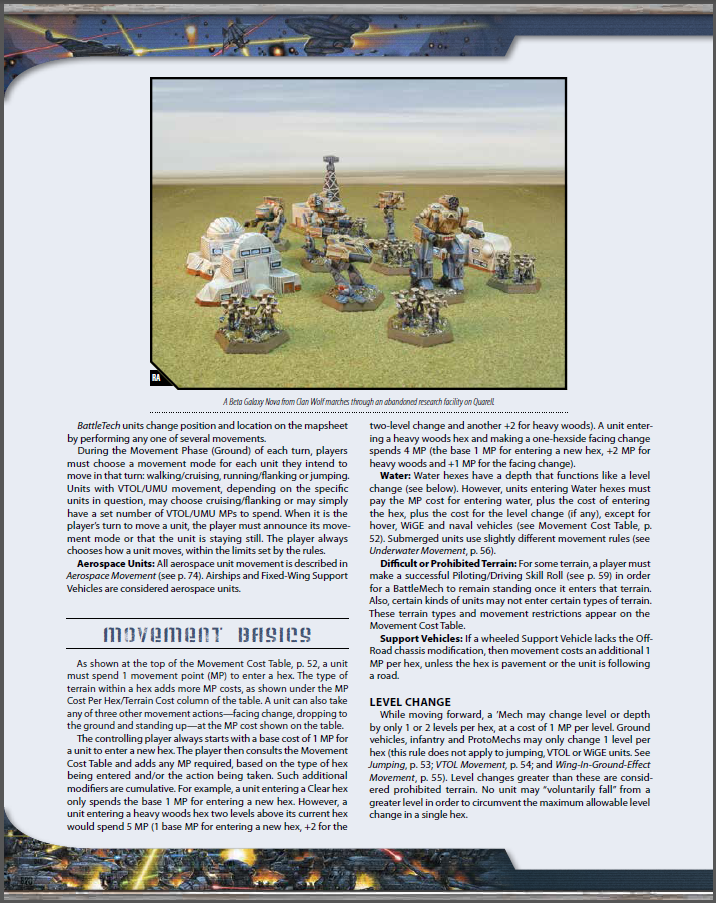
The Manual instead starts by explaining movement modes: the means by which you get MP. Then you learn how to spend that MP: first by change your facing, then by moving between basic hexes. Only then do you hit the rules for level changes and the like.

There was also a general attempt to compile information that, while in the rules, was not always placed to its best effect. The best example I can think of is the End Phase: that nebulous zone of gameplay in which a bunch of random things happen. In TW, there’s lots of mentions of the End Phase scattered throughout the book. But no rulebook has ever had a list of exactly what happens then. Worse is that some End Phase actions are mandatory, while others are merely optional, and with the optional ones, it’s annoying to remember later in the turn that you wanted to do that action but the time for it has already passed. So the Manual adds an End Phase checklist.
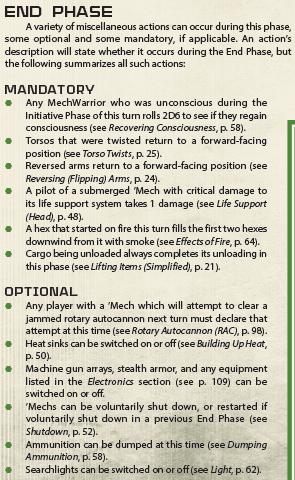
Another good example of this is the immobile status. BattleTech has a bunch of times where things have 0 MP but aren’t formally immobile. Keeping track of what’s actually immobile vs. not can be rather annoying, and TW doesn’t do that, so the Manual lists this all for you (both in movement and in combat, each of which is a logical location to check):

Then there’s presentation of information. There’s lots of occasions in the rules where an activity has a lot of modifiers or a list of conditionals to go with it. Whenever this was the case, the mods were separated out from the main text, instead of just burying them in a paragraph. That way the essential information, especially key numbers, leaps out at you.
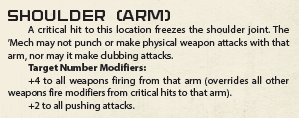
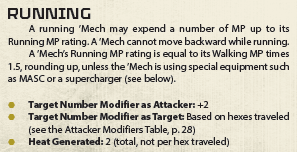
Finally, there’s segregation of information. We tried to keep the more unusual, rarely referenced information segregated from the main rules, even if technically an unusual rules section could fit with a main rules section. For example, Underwater Combat is in TW’s Combat section, which technically makes sense because it’s an offshoot of Combat. To me though, this was a big chunk of rules that rarely saw play and constantly got in the way when looking for something basic. So, we took the most basic elements of such oddball scenarios, covered that and only that in the relevant chapter (Movement or Combat), and then shunted the rest off to specialist sections. For example, movement in water of some sort is common, so that’s all in Movement. But fully submerged underwater combat is quite rare, so that just gets a quick mention in Combat and then you’re instructed to see The Battlefield chapter, which handles unusual environments.
Similarly, skidding is clearly a movement rule. However, it only applies in urban environments, and then the bulk of it only really applies if you fail your skidding check. If you do though, you then need literally three and a half pages of content to resolve the result. In TW that sits like a brick in the Movement chapter (where it takes up five pages). For the Manual, instead there’s a brief mention in Movement that tells you that skidding exists, and even how to resolve a skid check, so that you don’t necessarily have to start page flipping. It’s only if you fail that check that you need to run off to the Urban Combat chapter, where all the skidding failure rules are now. I’d say 95% of the time the overall result is much more useful to the reader that’s just trying to find basic, everyday movement or combat rules.

Compared to TW, the Manual also splits more of the key material out into separate chapters. Damage is removed from Combat and given its own chapter, both to make Combat more manageable in size but also because damage can occur during movement and in the Heat Phase (due to falling) as well. Piloting Skill Rolls are also separated out from their placement in TW’s Movement chapter, since PSRs can occur in the Movement, Combat, and Heat phases. Instead, the PSR rules are with the falling rules, in their own chapter.
The most important change in this regard is how Weapons and Equipment are handled. In TW, these rules were in the middle of the Combat chapter. Further, a lot of the rules information for weapons in TW is only found on the Weapons and Equipment tables at the back, in footnotes.
For the Manual, we instead have a dedicated Weapons and Equipment chapter. It has everything found in Total Warfare that is relevant to ’Mech-only combat. It also features the vast majority of the relevant weapons and equipment from Tactical Operations. All the game rules you need are in this chapter, leaving the summary tables to contain only the raw stats for each weapon. There’s even tonnage and critical space info, previously only in the TechManual.
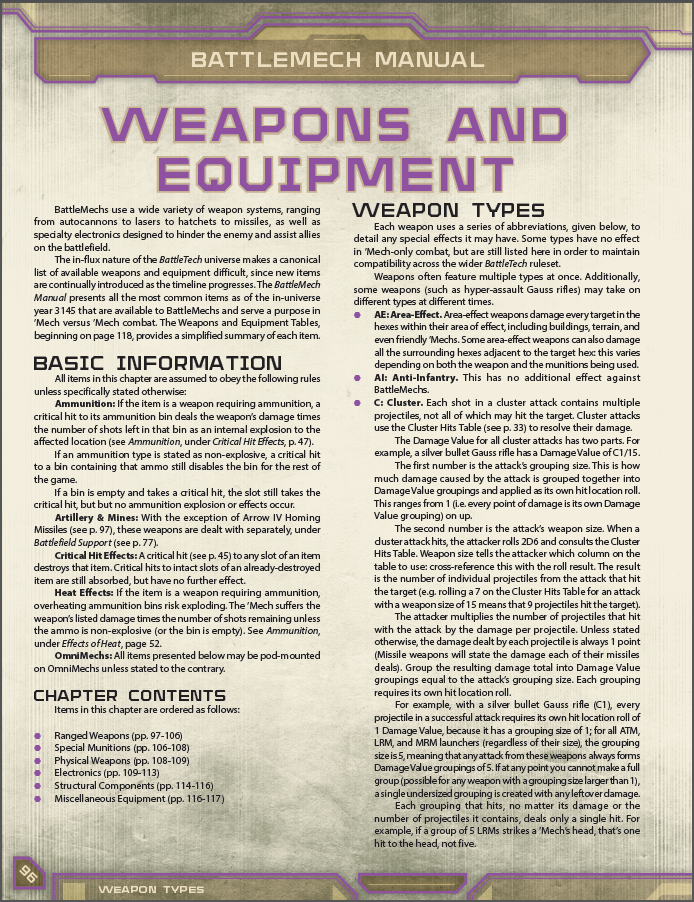
Now that we had our chapters, we made sure that they received a thorough review by outside eyes. For this we went to the people who have more BattleTech experience than almost anyone else: the Catalyst Demo Agents. Spearheaded by Mary Kaempen, lead BattleTech Demo Agent, the team pointed out all the spots that they’ve had issues with over the years running battles and teaching the game to others. The book is immensely better for their feedback.
As part of this, one of the demo agents mentioned that they kept running into the same set of common mistakes people were making. These sorts of misconceptions are tricky to correct, because people are convinced that their understanding is correct. As such, no matter how clear we make the rules in question, many won’t bother to look them up, because they already “know” how they work. The solution was to create a special Common Misconceptions chapter, a quick five pages that lists the things people unknowingly tend to do wrong. This should help end those BattleTech urban legends.
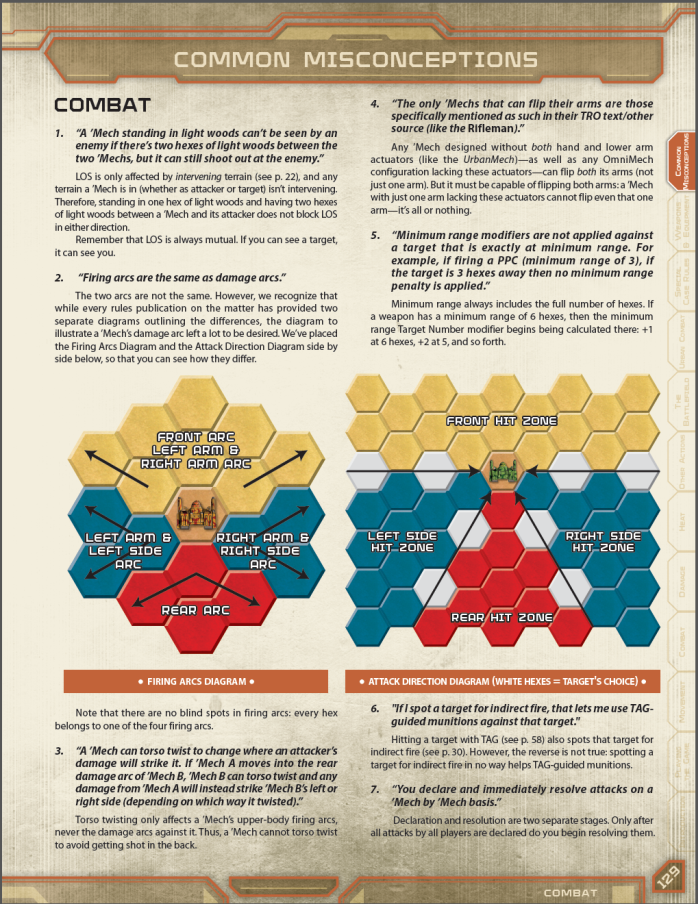
Appearance
What about appearance? Just as we had learned how to improve the text over the years, there were some solid ideas as to how to make the book more user-friendly visually. Again, this book was designed from the ground up to be used at the tabletop. We wanted the layout to match that. Ray Arrastia, in charge of graphic design for the Manual, created a crisp-looking page layout with some nice improvements.
For example, if you look at the picture of the Misconceptions chapter, posted above, note the chapter tabs on the right side of the page, there to easily orient the reader. The bottom corner of each page also has a text indicator as to where you are in the book, to help guide someone flipping through it.
My favourite element is how example text is handled. In TW, examples are part of the main rules text, albeit slightly indented and in italics. This makes them fairly easy to see, but places them in the midst of the rules, so that when you want just the rules, you sometimes have to wade through a great deal of example text to find it. With the Manual, an example is always out of the way, but instantly identifiable should you need it.

New Content
So what about new content? Overall, the idea was that this is a new presentation of existing rules, not a new edition. As such, we kept new rules to a minimum. However, there are a few.
For example, as part of showing off the depth of gameplay available, we decided to include a selection of the simplest and most popular optional rules from Tactical Operations (TO). TO is a 424-page monster, so we could never include more than a fraction of its content, but some of your favourites—such as sprinting, engine explosions, ejection, rapid-fire machine guns, and floating criticals—made it in. All are clearly marked as options. As Randall puts it, it’s 95% of what 95% of players use.

Here’s an all-new TO-type option for flamers, one people have requested for thirty years
Beyond that, we included some simplified forms of some Tactical Operations content. For example, TW just includes rules for the most common battlefield terrain types: woods, rubble, rough terrain, and water. The Manual expands this by adding in night fighting rules, plus those for mud, snow, ice, rain, wind, fog, swamps, and jungle—all reasonably common environments. In TO, some of those have extensive rules for getting stuck or otherwise endangered by the terrain, but we’ve cut that here in the interests of faster gameplay. Similarly, fire and smoke—a ruleset that goes back to the very beginning of the game—is featured in the Manual in a new, simplified form that allows you enjoy a bit of heat without rolling all day to track flame and smoke spread.
We also knew that, even for those players who like the ’Mech first and foremost, some people really enjoy the concept of laying minefields or raining artillery and air strikes on your opponent, but don’t want to have to learn the many pages of advanced rules normally required to do so. With the Manual’s all-new Battlefield Support Rules, you can accomplish all three in under five pages—complete with air interceptions and smoke and illumination artillery—instead of the 70 (!) pages the regular rules need instead.
Lastly, the Design Quirk concept, which allows players to quickly customize their machines to represent design oddities or battlefield travails, has proven quite popular ever since it was introduced in Strategic Operations. Numerous other quirks have been introduced in other books since then. The Manual collects all those quirks, applies all errata to them, expands them for further play, and adds several all-new quirks. It also features a canon Master Quirk List for the almost 500 BattleMechs that did not yet have any assigned.
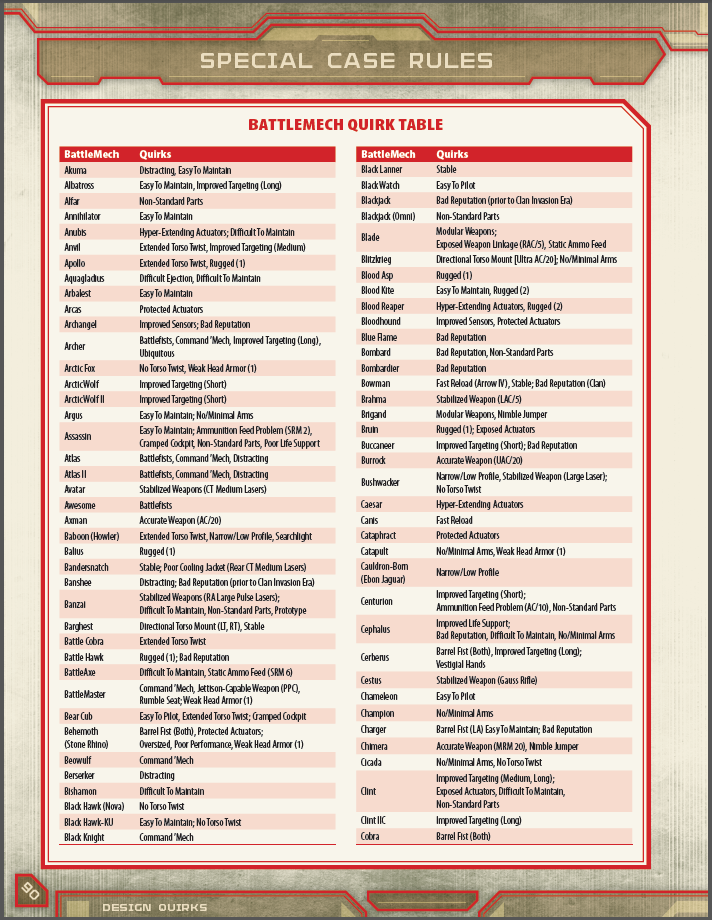
Also from Strategic Operations are the rules for hot-dropping ’Mechs from the sky directly into combat. These were again simplified (and cleaned up), so that you don’t have to know any of the aerospace rules or consult any other book to land an Atlas on somebody’s head.
So there you have it. The result is a 150-page rulebook that gives you everything you need to stride across the battlefields of the 31st century, in a clearer, easier-to-use fashion than ever before. If you were wondering why you might get the BattleMech Manual, I’m hoping this has helped make it clear. Thanks for reading!
-Keith Hann
To purchase a PDF or hardcopy of the Manual, follow this link:

